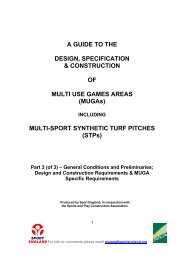View - North East Lincolnshire Council
View - North East Lincolnshire Council
View - North East Lincolnshire Council
You also want an ePaper? Increase the reach of your titles
YUMPU automatically turns print PDFs into web optimized ePapers that Google loves.
BOC Immingham Dissolved Acetylene Project Environmental Statement: Vol. 2 Main Text<br />
7.7 The ‘suitable for use’ approach consists of three elements:<br />
� ensuring that land is suitable for its current use;<br />
� ensuring that land is made suitable for any new use; and<br />
� limiting requirements for remediation to the work necessary to prevent unacceptable risks to<br />
human health or the environment in relation to the current use or future use of the land.<br />
7.8 Primary guidance for assessing and managing land contamination is presented in Contaminated<br />
Land Report (CLR) 11 35 . This provides a technical framework for identifying and remediating<br />
contamination through the application of a risk management process. The question of whether risk<br />
is unacceptable in any particular case involves not only scientific and technical assessments, but<br />
also appropriate criteria by which to judge the risk and conclude exactly what risk would be<br />
unacceptable.<br />
Legislation Relating to Controlled Waters<br />
7.9 Protection of groundwater from new developments is regulated in the UK by the updated<br />
Groundwater Regulations 2009 36 which predominantly control the acceptability of discharge of<br />
certain chemical species into groundwater from new activities, especially where the activities are<br />
not covered by other regimes. It regulates the following areas:<br />
� development of criteria for assessing good groundwater status;<br />
� identification and reversal of trends of chemical groundwater pollutants; and<br />
� measures to prevent or limit pollutant inputs into groundwater.<br />
7.10 The Water Framework Directive 2000 37 aims to provide a comprehensive and holistic water policy<br />
for Europe by establishing a consistent legal framework for the protection, improvement and<br />
sustainable use of water. The overarching objective is to protect aquatic ecosystems by ensuring<br />
that all surface, transitional, coastal and groundwater across Europe should reach good<br />
ecological, chemical and quantitative status by 2015.<br />
7.11 In addition, the Water Resources Act 1991 (as amended by the Water Act 2003) 38 aims to improve<br />
the management of water resources and protection to the environment by changing the way that<br />
water abstraction and impoundment is regulated.<br />
Environmental Damage Regulations<br />
7.12 The Environmental Damage Regulations, 2009 39 bring the EU Environmental Liability Directive of<br />
2004 40 into law in the UK. The overall objective is to ensure that the environment is fully protected<br />
against the most serious environmental damage. The Regulations require polluters to prevent and<br />
repair damage to water systems, land quality, species and their habitats and protected sites. If any<br />
business carries out an activity that causes environmental damage there is a requirement to<br />
remedy the damage and if there is a risk of damage from the business activities, this must be<br />
prevented.<br />
Environmental Permitting and Pollution Control for Contamination<br />
7.13 There is a wide range of legal requirements that address Environmental Permitting and pollution<br />
control for contamination. Best practice guidance documents have been produced by the EA and<br />
organisations such as the Construction Industry Research and Information Association (CIRIA)<br />
which are designed to prevent pollution during construction.<br />
5100935.404 Environmental Statement August 2011 89




